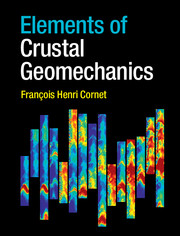Book contents
- Frontmatter
- Epigraph
- Contents
- Preface
- 1 Geomaterials and crustal geomechanics
- 2 Elements of rheology
- 3 Forces and stresses
- 4 Elements of kinematics
- 5 Elements of linear elasticity
- 6 From continuum mechanics to fluid mechanics
- 7 Elements of linear fracture mechanics
- 8 Laboratory investigations on geomaterials under compression 183
- 9 Homogenized geomaterials
- 10 Fractures and faults
- 11 Elements of seismology
- 12 Elements of solid–fluid interactions
- 13 Methods for stress field evaluation from in situ observations
- 14 Elements of stress fields and crustal rheology
- Appendix Elements of tensors in rectangular coordinates
- References
- Index
9 - Homogenized geomaterials
Published online by Cambridge University Press: 05 April 2015
- Frontmatter
- Epigraph
- Contents
- Preface
- 1 Geomaterials and crustal geomechanics
- 2 Elements of rheology
- 3 Forces and stresses
- 4 Elements of kinematics
- 5 Elements of linear elasticity
- 6 From continuum mechanics to fluid mechanics
- 7 Elements of linear fracture mechanics
- 8 Laboratory investigations on geomaterials under compression 183
- 9 Homogenized geomaterials
- 10 Fractures and faults
- 11 Elements of seismology
- 12 Elements of solid–fluid interactions
- 13 Methods for stress field evaluation from in situ observations
- 14 Elements of stress fields and crustal rheology
- Appendix Elements of tensors in rectangular coordinates
- References
- Index
Summary
Rock masses may be viewed as structures involving both solids and fluids, with complex interfaces. They involve discontinuities at all scales, whether these correspond to solid grain limits, to fractures or to faults. Furthermore, in the vast majority of cases, rocks and rock masses are naturally under triaxial loading compression, so that significant parts of these discontinuities support some shear stress.
Different approaches are followed for geomechanical investigations on rock masses, depending on their main focus.
In a rock mechanics approach, the rock mass behavior is often dominated by the elastic response of the solid parts and by the geomechanical characteristics of the discontinuities. Fluids are generally considered only through their local pressure values.
In a soil mechanics approach, the elastic behavior of the solid particles is considered to be negligible and therefore the geomechanical behavior of the equivalent homogeneous geomaterial depends on the size distribution and shape of the particles, on the friction between the particles, on the relative content of solid, water and air and on the flow characteristics of the fluids within the pore space (generally air and water).
In a hydrogeology approach, no attention is given to the solid part and only the motion of fluids (often only liquid water) is of interest.
In all these approaches, continuum mechanics principles are applied and, depending on the discipline, attention is focused on the elastic behavior of the solids with specific attention to the interfaces, or on the plastic behavior of the equivalent homogeneous geomaterial or on the flow of the fluids within a rigid solid structure.
However, in many geomechanical problems, whether in engineering applications or in the context of earth sciences, attention must be given to a mixture of rocks, soils and fluids with explicit consideration to fractures and faults and their topology, i.e. the structure and morphology of the individual fractures and faults as well as that of their networks.
- Type
- Chapter
- Information
- Elements of Crustal Geomechanics , pp. 218 - 252Publisher: Cambridge University PressPrint publication year: 2015



